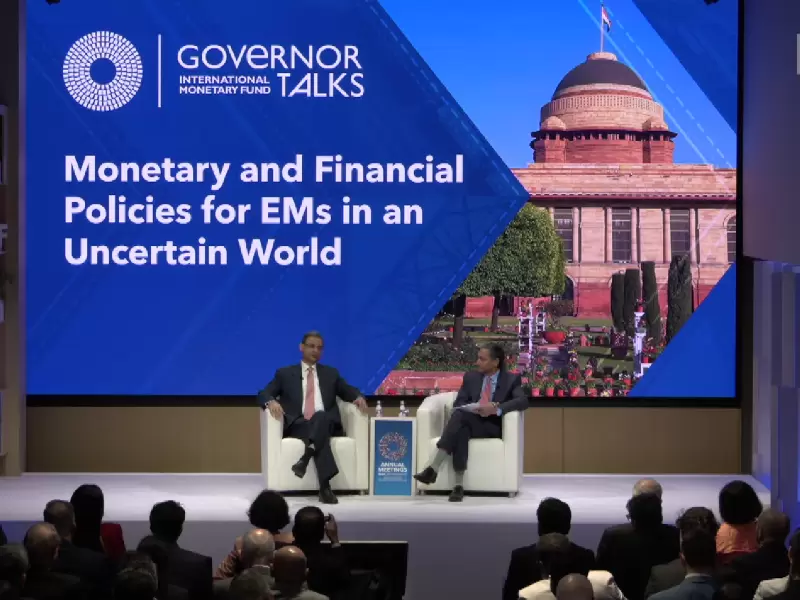Tariff pressures and currency volatility test emerging markets: RBI Governor
Malhotra outlined India’s inflation gains, fiscal prudence, and digital currency vision at IMF meet
 Sanjay Malhotra with Krishna Srinivasan at the event / Screengrab from YouTube/ IMF
Sanjay Malhotra with Krishna Srinivasan at the event / Screengrab from YouTube/ IMF
Reserve Bank of India (RBI) Governor Sanjay Malhotra on Oct. 15 said that tariff hikes, commodity price swings, and geopolitical tensions have compounded global economic uncertainty, posing major policy challenges for emerging markets.
Speaking at the International Monetary Fund’s Governor Talks – India: Monetary and Financial Policies for Emerging Markets in an Uncertain World, he said India’s macroeconomic fundamentals have remained resilient despite these headwinds.
Also Read: India central bank minutes show room for rate cuts as inflation outlook softens
“In a world of unprecedented uncertainty—high geopolitical tensions, elevated debt levels in advanced economies, and volatile tariffs—emerging markets like India face the dual challenge of containing inflation while supporting growth,” Malhotra said in a conversation with IMF Asia-Pacific department director Krishna Srinivasan.
Inflation management and fiscal coordination
Malhotra noted that while advanced economies continue to grapple with debt and growth fragility, India has successfully managed inflation and sustained robust growth.
“We have been able to manage our inflation very well—from around 8 percent to below target now, at an eight-year low of 1.5 percent,” he said. India’s growth, he added, remains among the strongest globally, with GDP expected to expand 6.6 percent this year and projected at 6.8 percent for 2026.
He credited India’s “coordinated effort between fiscal and monetary authorities” for this outcome, highlighting that food inflation—comprising 46 percent of India’s consumer price index basket—requires both supply-side and monetary responses. “A ministerial mechanism has been institutionalized to identify price pressures and take proactive action,” he said.
On the fiscal side, Malhotra underscored India’s commitment to consolidation. “Fiscal deficit is projected to decline to 4.4 percent of GDP for the central government, and combined state and central government debt is among the lowest among the top ten global economies—only Germany’s is lower,” he said.
Addressing a question on currency volatility, Malhotra acknowledged that India’s rupee had remained relatively steady compared to other emerging market currencies despite global shifts. “Yes, we have higher tariffs—around 50 percent—and capital outflows, but our policy is not to target any price level or band. We allow markets to determine the level, ensuring only that movements are orderly,” he said.
He stressed that India’s strong macroeconomic fundamentals, including a manageable current account deficit of about 1 percent of GDP and healthier corporate and banking balance sheets, were key to maintaining stability. “Our corporates are now flushed with funds, and we see green shoots of private investment,” he added.
Lessons for emerging markets
Responding to a question on India’s plans for a central bank digital currency (CBDC), Malhotra said the initiative is primarily aimed at improving cross-border payments rather than domestic transactions. “India’s domestic payment systems are already very efficient and low-cost. The CBDC’s real value will be in cross-border settlements. We are already running pilots at both retail and wholesale levels,” he said.
Calling for international cooperation, he urged other central banks to adopt similar frameworks. “Unless other countries also adopt CBDCs, the full benefits for cross-border payments will not be realized. This system offers all the advantages of stablecoins while retaining the integrity of fiat money,” he said.
Discussing India’s monetary policy evolution, Malhotra reflected on nearly a decade of flexible inflation targeting since its introduction in 2016. “The framework has made our policy more credible, transparent, and subject to public scrutiny. Inflation has come down by about two percentage points post-adoption,” he said.
He emphasized that flexibility within the inflation-targeting regime has been crucial, especially during crises such as COVID-19. “It allowed us to look through temporary price spikes and prioritize economic recovery,” he said.
The session, held on the sidelines of the IMF and World Bank Annual Meetings, underscored India’s growing influence in shaping monetary policy discourse among emerging markets, particularly as they navigate a more fragmented and protectionist global trade environment.
ADVERTISEMENT
ADVERTISEMENT
E Paper
Video



 Malvika Choudhary
Malvika Choudhary












Comments
Start the conversation
Become a member of New India Abroad to start commenting.
Sign Up Now
Already have an account? Login